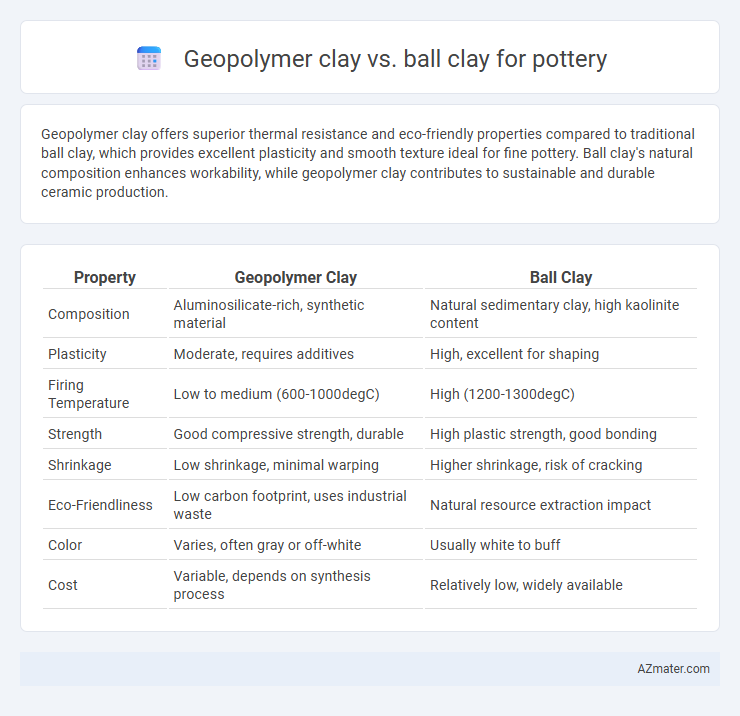Geopolymer clay offers superior thermal resistance and eco-friendly properties compared to traditional ball clay, which provides excellent plasticity and smooth texture ideal for fine pottery. Ball clay's natural composition enhances workability, while geopolymer clay contributes to sustainable and durable ceramic production.
Table of Comparison
| Property | Geopolymer Clay | Ball Clay |
|---|---|---|
| Composition | Aluminosilicate-rich, synthetic material | Natural sedimentary clay, high kaolinite content |
| Plasticity | Moderate, requires additives | High, excellent for shaping |
| Firing Temperature | Low to medium (600-1000degC) | High (1200-1300degC) |
| Strength | Good compressive strength, durable | High plastic strength, good bonding |
| Shrinkage | Low shrinkage, minimal warping | Higher shrinkage, risk of cracking |
| Eco-Friendliness | Low carbon footprint, uses industrial waste | Natural resource extraction impact |
| Color | Varies, often gray or off-white | Usually white to buff |
| Cost | Variable, depends on synthesis process | Relatively low, widely available |
Introduction to Geopolymer Clay and Ball Clay
Geopolymer clay is an innovative, eco-friendly material composed of aluminosilicate minerals activated by alkaline solutions, offering high thermal resistance and reduced shrinkage compared to traditional clay. Ball clay is a fine-grained, highly plastic sedimentary clay known for its exceptional plasticity and bonding properties, widely used in ceramics and pottery for its workability and firing characteristics. Understanding the distinct chemical composition and physical properties of geopolymer and ball clays is essential for selecting the right material for durable and sustainable pottery productions.
Chemical Composition Comparison
Geopolymer clay primarily consists of aluminosilicate materials rich in silicon dioxide (SiO2) and aluminum oxide (Al2O3), whereas ball clay contains higher amounts of kaolinite, mica, and quartz with notable organic carbon content. The chemical composition of ball clay includes roughly 50-60% silica, 20-30% alumina (Al2O3), and variable iron oxide (Fe2O3), contributing to its plasticity and firing properties; geopolymer clay's synthetic aluminosilicate framework provides superior thermal stability and mechanical strength. The differences in mineralogical and elemental composition between geopolymer and ball clay significantly impact their behavior during firing, glaze development, and finished pottery durability.
Physical Properties and Workability
Geopolymer clay exhibits higher mechanical strength and thermal resistance compared to ball clay, making it suitable for durable pottery applications. Ball clay offers superior plasticity and smooth texture, enhancing workability and ease of shaping in ceramic processes. The denser particle structure of geopolymer clay can reduce shrinkage during drying, whereas ball clay's finer particles improve moldability and surface finish.
Firing Temperatures and Methods
Geopolymer clay typically requires lower firing temperatures, often around 300-600degC, as it hardens through chemical curing rather than traditional kiln firing, making it ideal for energy-efficient pottery applications. In contrast, ball clay is fired at much higher temperatures, usually between 1200-1300degC, to achieve vitrification and strength in ceramics, necessitating conventional high-temperature kiln methods. The distinct firing processes influence the workability, durability, and final texture of pottery, with geopolymer clay offering quicker setting times and ball clay providing superior plasticity and finish.
Durability and Strength Differences
Geopolymer clay offers superior durability and higher compressive strength compared to traditional ball clay, making it ideal for applications requiring long-lasting and robust ceramic products. Ball clay, while plastic and easy to work with, tends to have lower mechanical strength and is more prone to shrinkage and cracking during firing. The enhanced chemical stability and molecular structure of geopolymer clay contribute to its improved resistance to thermal stress and mechanical wear in pottery.
Environmental Impact and Sustainability
Geopolymer clay significantly reduces environmental impact compared to traditional ball clay by utilizing industrial by-products like fly ash and slag, lowering carbon emissions and conserving natural resources. Ball clay extraction involves extensive mining activities that disrupt ecosystems and deplete finite sedimentary deposits, leading to soil erosion and habitat loss. Choosing geopolymer clay for pottery production promotes sustainability through reduced landfill waste and a smaller carbon footprint, aligning with eco-friendly manufacturing practices.
Artistic Qualities: Texture and Finish
Geopolymer clay offers a unique, smooth texture that allows for precise detailing and a modern, polished finish ideal for contemporary pottery artists. Ball clay, with its high plasticity and fine grain, provides superior workability and a traditional, glossy surface after firing, preferred for classic pottery styles. The choice between geopolymer and ball clay directly influences the tactile feel and visual appeal of the final ceramic piece, impacting artistic expression and durability.
Availability and Cost Analysis
Geopolymer clay offers a synthetic alternative with consistent availability due to its manufactured nature, while ball clay is a natural resource subject to geographic and seasonal constraints affecting supply. Cost analysis reveals geopolymer clay generally incurs higher upfront expenses due to specialized production processes, whereas ball clay remains more economical owing to widespread mining and established supply chains. Potters must weigh the stability of geopolymer clay availability against the fluctuating but lower-cost ball clay options when sourcing materials.
Suitable Applications in Pottery
Geopolymer clay offers excellent heat resistance and chemical durability, making it suitable for functional pottery such as cookware and outdoor ceramics exposed to harsh conditions. Ball clay, characterized by its plasticity and fine particle size, is ideal for shaping intricate designs and smooth surfaces in decorative pottery and fine ceramics. Potters often blend ball clay with other clays to enhance workability and strength, whereas geopolymer clay is favored for producing eco-friendly, high-performance ceramic pieces.
Choosing the Right Clay for Your Pottery Projects
Geopolymer clay offers superior durability and heat resistance compared to traditional ball clay, making it ideal for functional pottery requiring high strength and thermal stability. Ball clay, prized for its plasticity and smooth texture, provides excellent workability and is preferred for detailed sculptural or decorative ceramics. Selecting the right clay depends on project requirements such as firing temperature, desired finish, and structural integrity--geopolymer clays suit industrial or heat-resistant pieces, while ball clays excel in artistic, finely detailed pottery.

Infographic: Geopolymer clay vs Ball clay for Pottery
 azmater.com
azmater.com